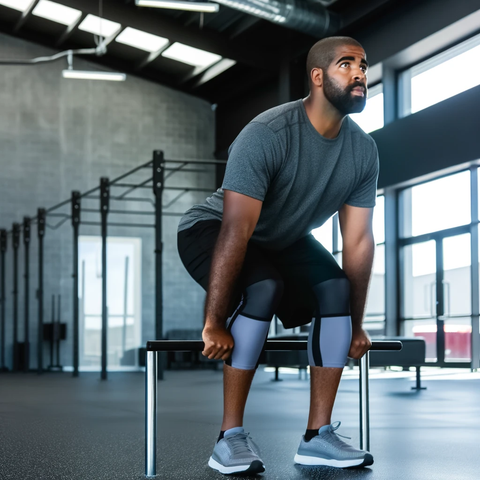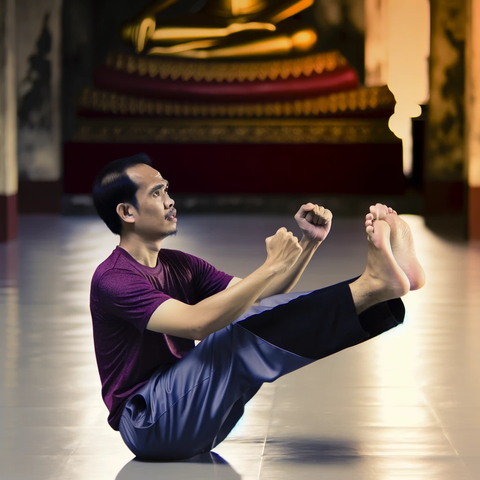Contents (Jump to a section)
Best Stretches for Tight Achilles: How to Stretch Tight Achilles For Fast Results

- What Causes a Tight Achilles in the First Place?
- Why a Tight Achilles Cannot Be Left Unchecked
- Should I Stretch a Tight Achilles?
- How to Stretch a Tight Achilles Tendon: the Best Stretches for Tight Achilles Tendons
- Best Stretches for Tight Achilles Tendons
-
Here are some additional achilles exercises
- 6.1 Seated Towel Stretch
- 6.2 Toe Taps
- 6.3 Resistance Band Dorsiflexion
- 6.4 Downward-Facing Dog
- How Long Does it Take to Loosen a Tight Achilles?
- Other Tips for Loosening Up a Tight Achilles Tendon
- Advice on Preventing Tight Achilles Tendons in the Future
- Final Thoughts on How to Stretch a Tight Achilles Tendon
Are you experiencing tightness or discomfort in your Achilles tendon? You're not alone. Many people, especially athletes and those who spend a lot of time on their feet, suffer from tightness in their Achilles.
This can cause constant pain, discomfort, and even limit your mobility. If you work on your feet, it can be especially painful and difficult. So, how can you deal with a tight Achilles?
One of the best ways to find relief is to do stretches for tight Achilles. In this article, we will explore how to stretch a tight Achilles and show you some of the best stretches for tight Achilles tendons.
These stretches can be done at home or in the gym, and they can help improve your flexibility, reduce pain and prevent future injuries. So, whether you're a professional athlete or someone who spends a lot of time on their feet, read on to learn how to stretch your tight Achilles for fast results.
What Causes a Tight Achilles in the First Place?
The Achilles tendon, which connects your calf muscles to your heel bone, is one of the most important tendons in your body, allowing you to walk, run, and jump.
So, why is my Achilles tight? A tight Achilles tendon can be caused by a number of factors - here are some of the most common culprits.
- Overuse, particularly in activities that involve repetitive jumping, running or sudden changes of direction. This type of strain can cause inflammation in the Achilles, resulting in tightness and pain.
- Inadequate stretching or warm-up before exercise. Tight calf muscles can put additional strain on the Achilles tendon, causing it to become tight and uncomfortable.
- Age can also play a role in the development of a tight Achilles. As we get older, our tendons become less elastic, which can result in increased stiffness and tightness.
Other factors that may contribute to a tight Achilles include improper footwear, existing injuries, and genetics.
Why a Tight Achilles Cannot Be Left Unchecked
While it might be tempting to ignore your tight Achilles, hoping the discomfort will go away on its own, this can lead to much more serious problems.
When the Achilles tendon is tight, it can become strained and inflamed, causing pain and discomfort. This can make it difficult to perform everyday activities such as walking, climbing stairs, or even standing for extended periods of time.
If left unchecked, a tight Achilles can also lead to more severe injuries such as tendonitis, tendinopathy, or even a rupture of the Achilles tendon. These injuries can be debilitating and require extensive rehabilitation, potentially keeping you out of your regular routine for weeks or even months.
A tight Achilles can also cause biomechanical imbalances in the lower body, affecting the knees, hips, and lower back. This can lead to pain and discomfort in these areas, making it difficult to perform everyday activities or exercise.
Should I Stretch a Tight Achilles?
So, should I stretch a tight achilles? Or, will this end up doing more harm than good? The answer is yes - tight achilles stretches can work wonders to provide relief!
In order to prevent the potentially serious issues described above, it's important to address tightness in the Achilles tendon early on. By learning how to stretch a tight Achilles, you can alleviate discomfort and prevent more serious injuries from occurring.
Stretching can also help improve blood flow to your Achilles area, which can reduce inflammation and promote faster healing, getting you back on your feet before you know it. By stretching regularly, you can maintain the health and flexibility of your Achilles tendon, which can help prevent future injuries.
How to Stretch a Tight Achilles Tendon: the Best Stretches for Tight Achilles Tendons
Let’s now take a look at how to stretch a tight Achilles. We’ll outline some of the best stretches for tight Achilles tendons that you can even do from the comfort of your living room.
Tips for Stretching a Tight Achilles in General
Firstly, it's important to warm up before you start stretching. This can be done with light cardio exercise or by performing dynamic stretches that involve movement, such as leg swings or walking lunges. This helps to increase blood flow to the muscles and prepares them for stretching.
When you’re first learning how to stretch a tight Achilles, it's important to start slowly and gently. Avoid bouncing or jerking movements, which can lead to injury. Instead, hold each stretch for 15 to 30 seconds and gradually increase the intensity as your muscles begin to loosen up.
Maintaining proper form during stretching is also crucial for preventing injury and getting the most benefit. For example, when learning how to release tight calves and stretching the calf muscles and Achilles tendon, keep your back straight and your heel on the ground. Avoid leaning forward, as this can put unnecessary strain on your lower back.
Whether you’re doing stretches for tight glutes or learning how to fix tight hamstrings, proper breathing is important. Take deep, slow breaths as you hold each stretch, inhaling through your nose and exhaling through your mouth. This can help to increase relaxation and reduce tension in the muscles.
It's important to note that stretching should never cause pain or discomfort. If you experience significant pain or discomfort while stretching your Achilles tendon, stop immediately and seek medical attention. Additionally, it's important to avoid stretching a tendon that is already inflamed or injured, as this can worsen the condition.
If you’re looking for the most comfortable, safe way to do stretches for tight Achilles tendons, you’ll love flexibility equipment like the CastleFlexx. The CastleFlexx is specifically designed for comfort and portability, making it the best stretching device that you can use at home or on the go.
The best part is that the CastleFlexx isn’t just perfect for stretching your Achilles - you can use it to relieve tension across your entire body. Whether you’re wondering how to increase hip mobility or how to stretch shins, you’ll love discovering the many benefits of assisted stretching with the CastleFlexx.
Best Stretches for Tight Achilles Tendons
Here are some of the best stretches for tight Achilles tendons. Each of these can be done in the comfort of your home (or anywhere you like) with a little help from the CastleFlexx.
Seated calf stretch

This targets the soleus muscle of your calf and can help to reduce tension in your Achilles. Sit on the floor with your legs straight out in front of you. Put one heel in the CastleFlexx and use the device to gently pull your foot towards you. You should feel a stretch in your calf and Achilles tendon. Hold for 15-30 seconds and repeat on the other leg.
90-degree Calf Stretch

You can also try a 90-degree calf stretch, which releases lower calf tension around your Achilles. Lie down with one foot on the floor and one foot in the air. Put your raised foot inside the CastleFlexx and, without bending your knee, gently pull your raised leg towards you, until it is almost at a 90-degree angle to your torso. Hold for 15-30 seconds on each leg.
Calf Raises with Eccentric Emphasis

Stand on a flat surface with your feet hip-width apart. Rise onto your toes, lifting your heels off the ground. Slowly lower your heels back down, emphasizing the eccentric phase.Perform 3 sets of 15 repetitions to strengthen the calf muscles and promote Achilles flexibility.
Runners Stretch

Begin in a lunge position, with one foot forward and the other extended straight back. Keep the back leg straight, press the heel firmly into the ground. Lean forward slightly, feeling the stretch along the back of the extended leg. Hold for 15-30 seconds and switch sides, repeating the stretch.
Toe-to-Wall Stretch

Stand facing a wall with your hands on the wall at shoulder height. Place one foot forward and the other back, keeping both heels on the ground. Slowly lean your hips forward, feeling the stretch in the calf and Achilles. Hold for 15-30 seconds, then switch the position of your feet and repeat.
Heel Drop Stretch

Stand on an elevated surface with your heels hanging off the edge. Slowly lower your heels towards the ground, feeling a stretch in the Achilles. Hold for 15-30 seconds, then return to the starting position. Perform 3 sets of 10 repetitions to improve flexibility.
Seated Ankle Stretch

Another great option is a seated ankle stretch. Sitting in a chair, raise one foot in front of you, trying not to bend your knee. Put your heel in the CastleFlexx and use the device to gently pull your toes back towards your body slightly. Pull and release 10 times, then repeat for your other leg. This stretch strengthens the Achilles tendon, helping to prevent tightness and other conditions like tendonitis.
This is just the beginning of what you can achieve using the CastleFlexx for fascial stretch therapy. Remember to start slowly and gently, and never push through pain or discomfort.
Here are some additional achilles exercises
Discover a series of targeted exercises designed to Achilles Tendon Exercises Enhancing Strength and Flexibility.
Seated Towel Stretch

Sit with your legs stretched out in front. Loop a towel around the ball of your foot.Gently pull the towel towards you, feeling a stretch in the calf and Achilles.
Toe Taps

Sit with your legs straight. Lift your toes toward the ceiling, then lower them back down. Repeat to improve flexibility and strength.
Resistance Band Dorsiflexion

Sit with your legs extended and a resistance band looped around a fixed point. Hook the band around the top of your foot and gently pull toes towards you against the band's resistance.
Downward-facing dog

It’s a well-known yoga pose renowned for its effective stretch targeting the back of the legs, particularly the calf muscles.
How Long Does it Take to Loosen a Tight Achilles?
Just like asking how long does it take to improve flexibility, the length of time it takes to loosen a tight Achilles tendon can vary. Usually, it depends on how severe the tightness is, how often you stretch, and your overall fitness and flexibility. The best way to speed up your recovery is to stretch consistently, and stay patient. Tightness in the Achilles tendon may take several weeks or even months of regular stretching to fully alleviate.
It's important to remember that trying to rush the healing process or pushing through pain can actually lead to further injury. Make sure you listen to your body and give it the time it needs to heal and regain flexibility.
Other Tips for Loosening Up a Tight Achilles Tendon
As well as doing stretches for tight Achilles, there are a few other things you can do to loosen up your Achilles and relieve tension:
- Wear supportive shoes that offer good support and cushioning to reduce strain on your Achilles tendon
- Use strength training for muscles in your legs and feet to help support the Achilles tendon
- Stay hydrated, as it is essential for overall muscle health and can help prevent cramping and tightness in your Achilles
- Apply ice to your Achilles to reduce inflammation, pain, and swelling
By incorporating these tips into your daily routine, you can help loosen up a tight Achilles tendon and prevent future injuries.
Advice on Preventing Tight Achilles Tendons in the Future
Rather than treating an Achilles that’s already tight, a better solution is to prevent tightness in the first place. A great way to do this is by improving your flexibility and ankle mobility. This helps to support the Achilles tendon, preventing injuries and tightness even when you’re most active. Wondering how to increase ankle mobility? The CastleFlexx can help!
It’s also important to gradually increase your activity level. When you ramp up too quickly, you can cause overuse injuries like shin splints as well as Achilles tightness. If you have any idea how long to heal shin splints, you’ll know that it’s better to focus on prevention by slowly increasing your workload and listening to your body along the way.
Final Thoughts on How to Stretch a Tight Achilles Tendon
Now that you know how to stretch a tight Achilles, you can easily find relief from Achilles and calf tightness. With the right stretches, you can leave Achilles tightness behind for good, and get back to your active lifestyle.
The CastleFlexx is the best way to stretch out a tight Achilles tendon, and can even relieve tension across your entire body. Whether you have a tight hamstring causing knee pain, or a tight Achilles tendon that’s cramping your style, you can safely, quickly, and easily find relief with the CastleFlexx.
Leave Achilles tightness and discomfort behind for good - get your CastleFlexx today!
